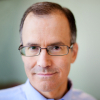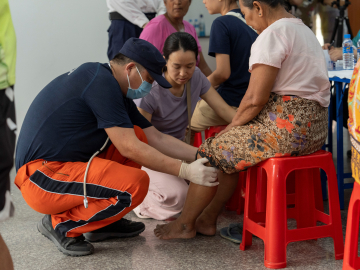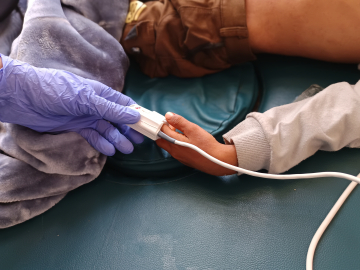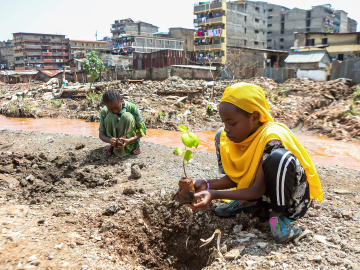Bloomberg American Health Summit 2018
Americans face a lot of health problems—youth at risk, the opioid crisis, and a mental health care crisis to name a few—but the inaugural Bloomberg American Health Summit is all about solutions. GHN will be blogging the Summit today and tomorrow right here, and you can watch the summit video here.
5 Big Challenges, 5 Ways to Keep the Conversation Going
Capping off a day and a half sprint through 5 major public health challenges, Bloomberg American Health Initiative Director Joshua Sharfstein and Associate Director Michelle Spencer sent participants off with 5 opportunities to stay connected and work together:
1. Sign up for updates at americanhealth.jhu.edu.
2. Recommend the Bloomberg Fellows program to rising stars on the front lines of these challenges.
3. Search for common ground—and the best evidence to frame discussions
4. Listen to the voices of people affected—to find solutions based in reality, equality, and humanity.
5. Be strategic, be creative, be relentless.
3 Takes on Violence Prevention
James Timpson, Director of Youth Work and Crisis Intervention, Roca Baltimore
“It’s not only the role of the police because communities are made up of people who live there. People have to take responsibility for their own communities. We know the things that are happening. Why shouldn’t we be the ones to think about preventing these things?
Mary Koss, Regents’ Professor, Mel and Enid Zuckerman College of Public Health, University of Arizona
“[Restorative justice] gives the victim the validation that she or he is seeking. It activates the support of family and friends. It makes it clear a wrong was done.
Daniel Webster, Bloomberg Professor of American Health, Johns Hopkins Bloomberg School of Public Health
“Restricting the number of alcohol outlets and their business hours [in a community] leads to less violence.”
Climate Change’s Threat to American Health

Harvard Professor Gina McCarthy and Hopkins Professor Tom Burke share ideas on environmental health. (Image: Courtesy)
Former EPA administrator Gina McCarthy has an unambiguous message on climate change and its impact: “Climate change is really the greatest public health threat of our time.” During a Bloomberg American Health Summit discussion on Nov. 30 with her former EPA colleague, Tom Burke, McCarthy added, “Mostly, it’s about a threat to our children, and what kind of future we want to leave them.”
Highlights from a subsequent interview with the professor of the Practice of Public Health at the Harvard T.H. Chan School of Public Health:
On on climate change’s immediate threats: "We’re talking about communicable diseases that we’re seeing here in the United States that never existed before."
On the importance of better science communications: "... scientists often times are not the best communicators because they tend to speak in hypotheticals when the world wants certainty."
On the Trump administration changes at the EPA: "The good news is that most of those rollbacks are falling away in the courts and they are not going to be very successful because they are not following the science and the law and doing the public process that we did."
Read the full Q&A here.
Boston’s North Star for Adolescent Health
How do you use a public health approach to work with adolescents? In Boston, they’re making sure that it’s timely, actionable and used to drive problem implementation, Monica Valdes Lupi, Boston Public Health Commission executive director, told Bloomberg Professor of Public Health Tamar Mendelson.
But the North Star for her commission is to ensure that their strategy is grounded in racial justice and health equity. Staying true to that means engaging youth, and making sure their voices are included.
Boston’s public health leaders kept that in mind for the design of their Start Strong peer-based curriculum for high schoolers. They inform each step of the program, which addresses self care, violence prevention, and advocacy. For example, one thing that kept coming up was the influence of sexually explicit media in their relationships, and it became clear they needed skills to navigate what was, in essence, pornography, with unhealthy stereotypes and portrayals of relationships. Now, the program draws from a porn literacy curriculum with a facilitator’s guide designed by students.—DKM
Local Level Action on Opioids
Pennsylania Gov. Tom Wolf wants to make his state a place where nobody dies from a substance use disorder.
To do that, he said, we need to look at it as a medical issue, as a chronic disease, and treat it that way. And our medical system has to embrace it, he said during a panel moderated by Michael Botticelli, executive director of the Grayken Center for Addiction at Boston Medical Center.
Chinazo O. Cunningham, professor of Medicine, Albert Einstein College of Medicine, agreed that’s important, but noted that historically our system hasn’t been set up that way. “We need primary care providers to change their mindset to treating substance use disorders along with diabetes, heart disease …we need to mainstream it with the rest of the health care system,” she said.
Rhode Island health commissioner Nicole Alexander Scott described some of the ways her state is advancing those strategies—pinned on the goal of saving lives through better treatment and reversal. With that we were able to put policies in place to work better with hospitals, establishing levels of care and minimum standards of care, and expanding access to treatment.
In closing the panelists each shared what they want to see happen next:
- Tom Wolf: Broader recognition at the federal level that this is a medical problem
- Nicole Scott: We’ve put the systems in place; now we need to make sure everyone has access
- Chinazo O. Cunningham: We need to incentivize medical schools, residencies and health systems to provide education and training.—DKM
A Partnership Against Opioids, Explained
In a keynote talk at the summit on Friday morning, Michael R. Bloomberg bluntly explained why he’s investing $50 million in a unique partnership that will respond to the opioid epidemic in up to 10 states.
“Our leaders in Washington have failed to meet the challenge” of the opioid crisis, Bloomberg said. “We can’t wait another day. We have to act right now.”
Calling the epidemic a “national crisis,” Bloomberg explained the kind of actions he expects that the new partnership will take. They include: Reducing over-prespections, increasing access to treatment, collecting and sharing data, and identifying new ways to stop addiction and overdoses.
Successful efforts can create a blueprint for all states to follow, he said.
“We know that smart policies improve and lengthen lives,” Bloomberg said, citing a 3-year increase in life expectancy that occurred in New York City during his 12-year tenure as mayor.
The fact that 130 Americans die each day from opioid overdoses underscores the need for a more rapid and robust response, he said. “Until the federal government responds with the urgency this epidemic requires, we will step in to give the states the evidence [and support] they need to take bold and decisive action.
Bloomberg spelled out 5 goals for the country to achieve in the next 5 years:
- All doctors will follow CDC prescription guidelines.
- All insurance copies provide coverage for alternative treatments like physical therapy.
- All Americans struggling with opioid addiction will have access to treatment.
- All jails will provide lifesaving addiction treatment.
- And stigma surrounding opioid addiction and treatment will be reduced.
“I know we can turn the tide on this epidemic,” Bloomberg said.—BWS
A $50 Million Infusion in the Opioid Fight

Protesters attend the Hope Not Heroin march and rally in Norwalk, Ohio in July 2017, calling on increased federal efforts combatting the opioid crisis. (Image: Spencer Platt/Getty Images)
Following yesterday’s dismal news of a yet another decline in US life expectancy, Michael R. Bloomberg announced today that he will put $50 million into helping up to 10 states fight the opioid epidemic over the next 3 years.
“We are experiencing a national crisis: For the first time since World War I, life expectancy in the U.S. has declined over the past three years—and opioids are a big reason why,” said Bloomberg, founder of Bloomberg Philanthropies and WHO Global Ambassador for Noncommunicable Diseases, in a statement. “We cannot sit by and allow this alarming trend to continue—not when so many Americans are being killed in what should be the prime of their lives.”
The funds will support a unique collaboration between states, the CDC, academia and other organizations to improve treatment and prevention programs, develop novel interventions and share the most effective solutions.
Bloomberg will announce the support for states this morning at the inaugural Bloomberg American Health Summit in Washington, DC.
Brian W. Simpson, Global Health NOW
Ed. Note: Also worth reading: Feds still aren't up to dealing with opioid crisis, so we're stepping in: Bloomberg & Wolf – USA Today (op-ed)
Design Lessons

Cassandra Crifasi shows off a “coffee cup drone” she and others created during Thursday's design challenge hosted by the Center for Social Design at the Maryland Institute College of Art. (Image: Larry Canner)
Dean Ellen J. MacKenzie: We Know What We Need to Do
The summit's morning was full of hows, according to Ellen J. MacKenzie, dean of the Johns Hopkins Bloomberg School of Public Health. In her wrap up of early sessions, she noted they included: How to help youth at risk, how to work with law enforcement to reduce overdoses, how to rethink the abandoned lots of our cities, and how to re-imagine access to healthy food.
MacKenzie discerned a pattern in all of these efforts—that while our nation is facing difficult challenges, we are not helpless, she said. “We have evidence. We can listen. We can work together to devise strategies that take what works to scale and reverse the health trends that are hurting far too many Americans,” she said.
She also sees hope in the new generation of public health students, "...who will innovate in response to new challenges in ways we can only imagine. And when you marry their energy with knowledge, when you bring excitement together with evidence, you get change,” she said.—DKM
In Food Policy, Place Settings Matter
Sugary beverage taxes, farmers markets and climate change—all are disparate threads of food policy—which is, essentially, “the way we talk about how we organize the food system,” says the Center for a Livable Future’s Anne Palmer.
Federal and local food policy regulations and initiatives impact everything from land use to living wages. Problems like urban sprawl’s erosion of farmland and gaping health disparities have been met with evidential success like the addendum to the Austin, Texas climate plan to include food waste and production technologies or the minimum wage increase in Worcester, Massachusetts that expands household food purchasing choices. These successes underscore a critical aspect of food policy work: Place is everything.
“Something that might work on the west coast may not work in a rural city on the east coast,” says CLF’s Caitlin Misiaszek. So how do experts and advocates look at snarls in the system and determine solutions?
Enter data: a huge driver of advocacy to manifest informed policy—especially data that’s accessible and understandable.
CLF’s Maryland Food System Map, for example, is an interactive tool tracking everything from median household income to the locations of oyster sanctuaries. Not only can the map help policymakers and advocates pinpoint issue overlap and identify gaps, the tool is valuable for organizations needing to illustrate need or visualize successes for funding opportunities.
Palmer and Misiaszek also stress the importance of data augmented by key stakeholder input. Search the Food System map for “food deserts,” for example, and you won’t find any—but you will see “Healthy Food Priority Areas.” Community residents, as it turns out, prefer this and other less loaded terms like “Food Impact Areas” to the unpromising “food desert.”—LSR
Follow the Young
Early on the morning of February 14, Parkland, Florida was considered one of the safest cities in the nation. Then 17 students and staff members were shot and killed at Marjory Stoneman Douglas High School.
The tragedy led Stoneman student Sari Kaufman and many others to advocate for gun violence prevention. It gave rise to the March for Our Lives movement, galvanizing young people nationwide to change laws where adults had failed. In a powerful summit presentation with US Senator Chris Murphy and Everytown for Gun Safety president John Feinblatt, Kaufman and 3 other students schooled adults in the room on how to drive change:
Kaufman shared her secret to getting people involved: by explaining how gun violence can affect anyone—even those in supposedly safe cities. And she urges young people to engage with those who have opposing views, and have a healthy, not political, dialogue.
Her takeaway: “Once you get young people involved, you create a domino effect that gets adults involved.”
Taylor King, a University of Michigan student and survivor of gun violence, calls herself a “walking, talking encyclopedia of gun violence and gun violence prevention data.” She considers data the most potent tool for persuading others. Even when relating her own personal experience, she makes sure others see that gun violence is “a macro-level problem reaching into every aspect of our country.”
Her takeaway: “The culture of the gun lobby is a cult of misinformation. It is our duty to dispel these myths.”
George Mason University student Neuteyshe Felizor focuses on the practical—turning out voters who will hand power to those who believe in commonsense gun laws. A veteran of the 2016 get out the vote effort in Florida, Felizor advised summit attendees to work on raising the awareness of potential voters and get them to care about the issue—otherwise they won’t vote.
Her takeway: “A deeper incentive is 1-to-1 conversations when you are trying to get out the vote.”
When Rutgers University student Jai Patel organized a Jersey City, New Jersey protest at city hall, he learned a valuable lesson when students from 2 areas of the city most affected by gun violence didn’t show up. A friend enlightened him. The students live in gang areas, and they would be risking their lives if they said anything wrong. His solution: Work with local leaders to host a comedy show fundraiser and support a local after-school program.
His takeaway: “The best way to get involved with these communities is to go to them.”
Sen. Murphy offered his own closing takeaway: “Ultimately, we need to let these kids lead. We need to put young people out front from every neighborhood, every school, and we need to do our part to support them. These are real leaders but they also the tip of the iceberg. There are thousands of other students doing a lot to make sure everybody understands gun violence is not a political issue. It is a public health issue.”—BWS

Bloomberg American Health Summit attendees work in a little networking around the sessions. Image: Courtesy of Bloomberg Philanthropies
Cooking Up Cures
By 2050, the only wheat grown in US will be in northern Minnesota and North Dakota—that’s just one example of the sweeping changes climate change is bringing to the food landscape shared by Kelly Brownell, who directs Duke University’s World Food Policy Center. And while there’s vast depth and expertise in key fields needed to address the problem—food insecurity, nutrition, obesity, agriculture—they are often poorly connected and competing for resources. A desire to bridge the experts led to the creation of his center, which looks for opportunities like creating model food communities.
Taking produce trucks for low-income neighborhoods as one example, he said it’s important to also think through ownership. Is it an NGO, and if so, would it be more valuable to give money to a minority entrepreneur of color to launch the truck? “It’s important that we feed the world—but it needs to be done right,” he said. And who owns things will be a very important part of the picture.
Panelist Chris Bradshaw, executive director of Dreaming Out Loud in Washington, DC, agrees that community ownership is key. His project, offering character and leadership opportunities in underserved areas of Washington, DC, didn’t set out to focus on food—but when the leaders noticed a lot of sugary snacks in their after-school programs, they realized there was a problem. That led to their community development efforts to fight obesity and food deserts, with an emphasis on restoring community ownership.
Getting pediatricians to prescribe cooking during well child visits is another idea, shared by panelist Sally Sampson, founder and President of Chop Chop, a quarterly magazine aimed at promoting a cooking culture for kids and their families. Sampson noted that there a lot of “don’ts” framing the conversation about obesity—not to eat junk food, etc. She launched Chop Chop to show how cooking can be a solution.
Journalist Judy Woodruff, moderating the panel, noted that getting people to invest in bold ideas can be challenging. She asked what it takes to be successful. For Bradshaw, it’s about having tough conversations and raising hard questions—about race, gender, and class—and letting people who have suffered the most lead those conversations.
Woodruff added that means that even when the national conversation isn’t focused on things that matter the most to you, you keep talking.—DKM
Baltimore's Lethal Ladies

The Lethal Ladies of Baltimore Leadership School for Young Women stomp for justice. Image: Brian W. Simpson
Go Green, Get Health
The environment’s impact on health is “pervasive, all over place and it is large,” said Ana V. Diez Roux, dean of the Dornsife School of Public Health at Drexel University. She offered 3 perspectives on environment and health to summit attendees:
The built environment and natural environments are inextricably linked, Diez Roux said. The natural environment influences how we build homes homes and cities. For example, homes are designed to protect from inclement weather—creating heating and cooling costs. And the location and density of homes have a major impact on transportation and energy use.
There’s no contradiction in promoting health and promoting the environment because there are “co-benefits” of environmental and health policies. For example, less processed meat means better health, and meat production is major source of forest disruption and greenhouse gas emissions. Another example: Reducing sprawl means promoting physical activity.
Good environmental policy is good health policy—and vice versa, she said.
We can still change the trajectory in environment and health. It requires confronting inertia and powerful entrenched opposition to establish evidence-based regulations.
She summed up her argument: “Think of environmental policies writ large as major tools to protect and improve health.”— BWS
Approaching Addiction and Overdose with Humanity
Law enforcement used to put the blame on victims—but the opioid crisis exposed the failure of that approach, said Arlington, Massachusetts Chief of Police Fred Ryan during a panel focused on the evolving fight against addiction and the opioid crisis in New England.
Panel moderator Maria Hinojosa, host of LatinoUSA, pinpointed a crucial link in the efforts of all the panelists: humanity.
Grace Keller, program coordinator of the Howard Center Safe Recovery, said that for the majority of her career there was a 2-year waiting list for treatment in Vermont. “As social workers we never signed up to say no to people … but that’s suddenly where we found ourselves,” she said. “Watching people die, go to jail, and lose custody of their children all while they were asking for help.”
“We all know the science, now we need to turn it into good policies,” Ryan said, and that means embracing harm reduction approaches. Burlington’s Chief of Police Brandon Del Pozo gave an example in Vermont—where the state’s attorney agreed not to prosecute for medications not prescribed that are saving lives. That translated into social workers like Kellner being able to offer treatment the same day that people ask.
Another example, Ryan said, is not standing in the way of safe use sites. Ryan mentioned an image that struck him in a Boston Globe article, depicting people using heroin on what’s known as the “Methadone Mile.” The image was intended to show the bad optics—but Ryan said that what he saw was hope because he saw clean, sterile needles from an exchange program, a clean bandage, and people who were not using alone.
It also means tackling the stubborn stigma that keeps people from getting—and giving—help. Keller suggested getting to know people who are struggling with disease as one way to start. Keller recounted a time that she had to administer rescue breathing to a man who was overdosing. The first thing he did when he came to was asked for help. “People want to be alive, they want to survive this epidemic.”
Now, in Vermont, they’re trying to give people access to medications that can help, like Buprenorphine. “We’re treating people where they need to be, with compassion,” she said.
“Our first job is to protect and rescue people in danger, if we do that compassionately we’re going to do it in a way that breaks down stigma. If we don’t do it we’re not doing our job,” said Del Pozo, closing out the morning session on addiction and overdose.—DKM
Reducing Chicago’s Gun Deaths
Chicago is bleeding. The city is one of the most violent in the US, said Arne Duncan, managing partner of the Emerson Collective and former US Secretary of Education.
He cataloged the evidence: An average of 1 school-age child is killed by a gun every 2 weeks. 83% of homicides in the city go unsolved. And despite strong gun laws in the city, guns pour in from Indiana, he said.
“We have raised a generation of kids … on gun violence,” Duncan said. He recalled numerous meetings with schoolchildren and asking how many of them know someone who had been killed by a gun. Frequently, 100% of the kids raise their hands.
There are solutions though, he said. An organization he works with in Chicago’s South Side has started to turn the tide by working directly with young men, hiring some as life coaches to work with their peers. (The evidence shows 80% of those shooting and being shot is young black men.)
“All we are trying to do is give young men a reason to put down their guns,” Duncan said. “We're starting to create momentum and hope.”
The work, which is reaching more than 1500 young men, is based on 4 key lessons, according to Duncan:
- “If we can create a sense of hope, young men will put down their guns.”
- “Relationships change lives.”
- “Our young men, many who have been shot or shot others, they are the solution. They are not the problem.”
- “We often talk about violence in the public health context. While violence is contagious, so too is peace. We have young men and women teaching peace in neighborhoods historically plagued by violence.”
As the numbers of gun deaths in Chicago have begun to decline, Duncan has a goal: “If we can get below 400 homicides in 2019, that would be the first time since 1965.” —BWS
Positive Notes

A classical quintet opens the summit's start. (Image: Brian W. Simpson)
The Bloomberg American Health Summit kicked off this morning with a positive note—or notes as a classical musical quintet played in front of an inspiring video of engaged students and community members working in critical public health issues.
Initial speakers framed the day:
- “There are now more than 40 nations around the world with higher life expectancies than the US.”—Kelly Henning, Public Health Lead, Bloomberg Philanthropies
- “The most important question: Can our country find a different path?” Michelle Spencer, associate director, the Bloomberg American Health Initiative
- “Our national health challenges are not red or blue.” Joshua Sharfstein, director, Bloomberg American Health Initiative
Michael R. Bloomberg: Our Work Is Only Beginning
In the face of today’s dismal news from the CDC that American life expectancy has suffered the most sustained decline in a century, Michael R. Bloomberg says there are reasons for hope. Before today’s opening of the Bloomberg American Health Summit, he explains why he’s optimistic. —The Editors
Life expectancy in the United States has fallen over 3 years. That is a tragic statistic, rooted in several daunting challenges—including an opioid crisis tearing families apart.
And yet, on the eve of the inaugural Bloomberg American Health Summit, there is reason to be hopeful. History shows that there is no public health challenge too great to meet. We just have to remember a simple fact: Change can start small—with individual actions, innovative ideas, and even chance encounters that lead to new dialogue and partnerships.
That is why we are looking forward to the week ahead, not only to discuss work already underway, but to lay the foundation for progress yet to come.
The public health community can accomplish great things. This summit will serve as a reminder that our work is only beginning—and our greatest breakthroughs still lie ahead.
Michael R. Bloomberg for Global Health NOW
Ed. Note: Michael R. Bloomberg is a benefactor of the Johns Hopkins Bloomberg School of Public Health, which publishes Global Health NOW.
Reversing the Decline in America’s Health
Kelly Henning, who directs public health programs for Bloomberg Philanthropies, says the inaugural Bloomberg American Health Summit is all about convening big thinkers to propagate solutions to big problems. In an Q&A with GHN, Henning explains how the Bloomberg American Health Initiative is forging nontraditional partnerships, why this summit differs from other public health conferences and which promising interventions to look for. Highlights:
On nontraditional partners: “We really wanted the Bloomberg American Health Initiative to include … NGOs, other sectors … school districts, fire departments—different affected communities so we can learn from each other and hear those voices from other parts of the country.”
On what to look for: I think there will be discussions about important medically assisted treatment of those with opioid addiction … assuring that we address inequity in all of these health areas. [And] we are going to hear about interesting work going on around the food supply and things that could be put in place to reduce obesity like menu labeling and food labeling.
Read the full interview here.
Livestream the Bloomberg American Health Summit
The inaugural Bloomberg American Health Summit—From Local Action to National Impact: Overcoming Challenges and Improving Health—will take place Thursday and Friday, Nov. 29 and 30.
The invitation-only event in Washington DC will gather experts and innovators working on 5 urgent US public health problems, including the opioid epidemic and gun violence. The Summit is part of the Bloomberg American Health Initiative, established with a $300 million gift from Bloomberg Philanthropies and based at the Johns Hopkins Bloomberg School of Public Health, which publishes Global Health NOW.
The summit livestream will be available on Nov. 29 and 30, starting at 9 a.m. Eastern on both days.
Solutions Summit
The list of problems afflicting health in the US seems long—and short on answers—but public health professionals, policymakers and other experts are gathering at the solutions-oriented Bloomberg American Health Summit in Washington DC, Nov. 29–30 to share their insights and experiences tackling some of the challenges. Read what's in store here.
Ed. Note: Michael R. Bloomberg is a benefactor of the Johns Hopkins Bloomberg School of Public Health, which publishes Global Health NOW.
Join the tens of thousands of subscribers who rely on Global Health NOW summaries and exclusive articles for the latest public health news. Sign up for our free weekday enewsletter, and please share the link with friends and colleagues: http://www.globalhealthnow.org/subscribe.html
Image: Scott Olson/Getty Images







